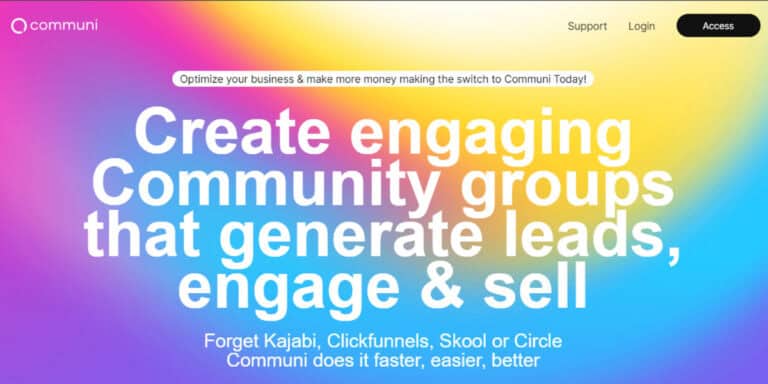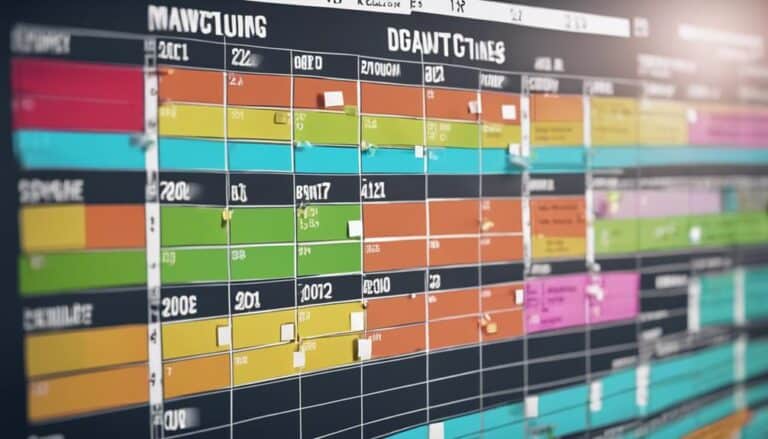Imagine the Gantt chart as the conductor orchestrating a symphony of tasks and deadlines in your project management journey.
As you navigate the complexities of project planning, mastering Gantt Chart Scheduling becomes your compass, guiding you through the intricate web of timelines and dependencies.
Understanding how to wield this powerful tool can be the difference between project success and failure.
So, are you ready to unlock the secrets to efficient project management through Gantt charts?
Key Takeaways
- Real-Time Progress Tracking for Project Monitoring
- Clarity on Task Dependencies for Seamless Workflow
- Timely Communication through Updated Gantt Charts
- Proactive Bottleneck Prevention for Efficient Project Management
Clear Project Scope
To effectively begin your project management journey, it's crucial to establish a clear and concise project scope outlining objectives, deliverables, and constraints. A well-defined scope serves as the foundation for successful project planning and execution. By clearly defining project objectives and constraints, you provide a roadmap for your project, ensuring that all stakeholders are aligned on the project's goals and deliverables.
A clear project scope enables you to outline specific tasks and goals that need to be accomplished throughout the project. It sets the boundaries for what's within the project's scope and what's not, helping to prevent scope creep and ensuring that resources are utilized efficiently.
Before diving into creating a Gantt chart to schedule project tasks, it's imperative to have a well-defined scope in place. This clarity will allow you to accurately plan and manage project tasks, leading to a more organized and successful project execution.
Task Listing and Sequencing
Breaking down project requirements into manageable units and logically sequencing tasks are essential steps in creating a well-structured project plan. Here are four key points to consider when it comes to task listing and sequencing:
- Task Listing: Begin by breaking down the project requirements into manageable units. This helps in organizing the work effectively and ensures that nothing is overlooked.
- Logical Sequencing: Once the tasks are listed, it's crucial to sequence them logically. This means arranging the tasks in a way that allows for smooth task progression and efficient project completion.
- Task Dependencies: Identifying task dependencies is vital for accurate scheduling. Understanding which tasks rely on others helps in determining the order in which tasks should be completed.
- Well-Structured Plan: Task listing and sequencing are foundational steps in creating a well-structured project plan. A well-organized plan sets the stage for successful project management and execution.
Realistic Duration Setting
Realistically setting durations for tasks in a project is crucial for preventing delays and ensuring accurate time estimations for each task. When creating a Gantt chart, it's essential to consider the task complexity, resource availability, and potential risks involved in each task to set realistic durations.
Overly optimistic estimates can lead to unrealistic expectations, causing project delays and hindering progress. By properly estimating task durations, you ensure that tasks are completed within the allocated time frame, directly impacting the overall timeline and success of the project.
The key to effective project management lies in setting realistic durations that align with the project's requirements and constraints. By incorporating these factors into your planning process, you increase the likelihood of meeting deadlines and achieving project milestones efficiently.
Resource Allocation Strategies
When considering resource allocation strategies, it's crucial to focus on efficient resource utilization and balancing project resources effectively.
By allocating resources thoughtfully, you can prevent overloading team members and ensure a smooth workflow throughout the project.
Balancing resource allocation among tasks and team members is key to meeting project objectives on time and enhancing overall project success.
Efficient Resource Utilization
Efficient resource utilization in project management involves strategically identifying and assigning the appropriate people, equipment, and materials to specific project tasks. To ensure effective resource allocation and maximize project efficiency, consider the following:
- Preventing Bottlenecks: Properly allocating resources helps prevent delays and bottlenecks in project execution.
- Optimal Productivity: Balancing resources optimally enhances productivity and project efficiency.
- Avoiding Burnout: Overloading team members with tasks can lead to burnout and decreased performance.
- Critical Aspect: Proper resource allocation is crucial for successful project management, influencing project timelines and overall outcomes.
Balancing Project Resources
To achieve optimal project performance, it is essential to carefully balance and allocate resources effectively among team members, equipment, and materials. Strategic resource management in project planning maximizes efficiency and productivity. Balancing project resources ensures that team members are not overloaded with excessive tasks, preventing delays and bottlenecks in project execution. Proper allocation of resources is crucial for meeting project deadlines and milestones. Below is a table illustrating resource allocation strategies:
| Resource Allocation Strategies | Description | Benefits |
|---|---|---|
| Identify required resources | Determine necessary people, equipment, and materials for tasks | Prevents resource shortages |
| Distribute workload evenly | Allocate tasks fairly among team members | Enhances team productivity |
| Monitor resource utilization | Keep track of resource usage to avoid bottlenecks | Improves project efficiency |
Milestone Integration
Integrating milestones into a Gantt chart enhances project tracking and ensures key accomplishments are monitored effectively. This process provides essential checkpoints to assess project progress and align team efforts efficiently. Milestones, represented by specific symbols on the Gantt chart timeline, serve as indicators for achieving project objectives and meeting deadlines effectively.
Here are four key reasons why milestone integration is crucial:
- Tracking Progress: Milestones help in tracking major accomplishments throughout the project timeline.
- Aligning Team Efforts: They ensure that all team members are on the same page regarding project objectives and deadlines.
- Staying on Schedule: Milestones act as checkpoints to keep the project on track and within the designated timeline.
- Measuring Accomplishments: Integrating milestones enables a clear measurement of project success and completion of critical tasks.
Gantt Chart Software Utilization
By utilizing Gantt chart software, project managers can harness advanced scheduling features to streamline project management processes effectively. Microsoft Project stands out for its comprehensive project management features, allowing for detailed scheduling and resource allocation.
Instagantt offers user-friendly tools that simplify the creation and customization of Gantt charts, enhancing project visualization.
Smartsheet's cloud-based platform facilitates collaborative project planning by enabling real-time updates and easy sharing among team members.
TeamGantt provides an intuitive design tailored for project teams, fostering seamless collaboration and task management.
Additionally, ProofHub's Gantt chart capabilities aid in project scheduling and resource management, ensuring projects stay on track.
Leveraging these software options enhances collaborative project planning, detailed scheduling, and efficient resource management, ultimately leading to successful project outcomes.
Continuous Chart Updates
Maintaining a consistent approach to updating Gantt charts is essential for ensuring accurate tracking of project progress. Continuous chart updates play a vital role in identifying any deviations from the planned schedule, allowing for timely adjustments to prevent delays and bottlenecks. Here are four key reasons why updating tasks, milestones, and dependencies in real-time is crucial for successful project management:
- Real-Time Progress Tracking: Regular updates on Gantt charts provide a real-time view of the project's progress, enabling you to stay informed about the current status of tasks and milestones.
- Clarity on Dependencies: Updating charts continuously helps in visualizing dependencies between tasks, ensuring that any changes or delays are promptly addressed to maintain project flow.
- Timely Communication: Updated Gantt charts facilitate effective communication among team members by offering a shared understanding of project timelines and responsibilities.
- Preventing Bottlenecks: By keeping the Gantt chart up-to-date, you can proactively identify potential bottlenecks and take corrective actions to keep the project on track.
Frequently Asked Questions
How Do You Make a Successful Gantt Chart?
To make a successful Gantt chart, prioritize time management, consider task dependencies, allocate resources effectively, identify critical paths, track milestones, collaborate with your team, monitor progress, communicate well, mitigate risks, and strive for project success.
Why Is the Gantt Chart Important in Project Scheduling?
In project scheduling, Gantt charts are vital for time management, tracking task dependencies, allocating resources effectively, visualizing progress, adhering to deadlines, coordinating projects, improving efficiency, and enhancing communication. Their clear visual representation aids in successful project management.
Can Gantt Chart Be Used for Scheduling?
Sure, you can definitely use a Gantt chart for scheduling. It helps with resource allocation, task dependencies, time management, progress tracking, deadline adherence, visual representation, project timeline, team collaboration, efficiency optimization, and risk mitigation. It's a powerful tool for project success.
How Can I Improve My Gantt Chart?
To improve your Gantt chart, utilize color coding for task types, set task dependencies for order, employ time tracking for progress, allocate resources efficiently, track milestones, monitor progress, customize options, enable collaboration, and integrate tools for seamless project management.
Conclusion
In conclusion, mastering Gantt chart scheduling is essential for successful project management.
Did you know that projects with well-defined milestones are 46% more likely to be completed on time?
By following best practices and utilizing the right tools, project managers can efficiently plan, track progress, and ensure the successful completion of their projects.
Keep honing your Gantt chart skills and watch your projects thrive!





